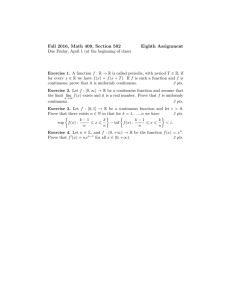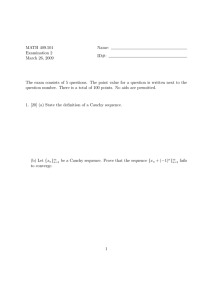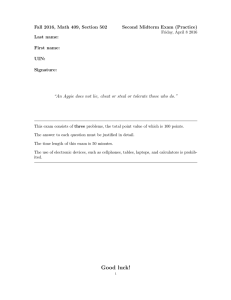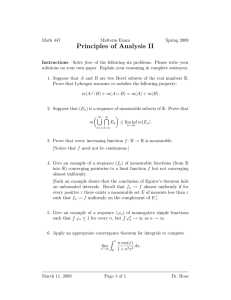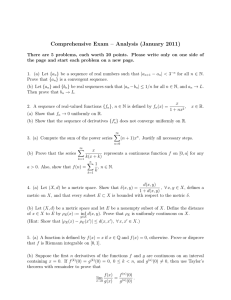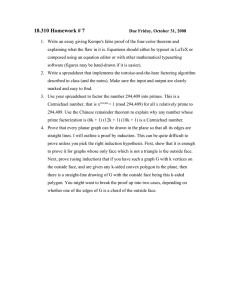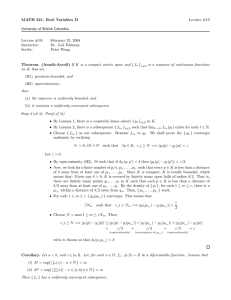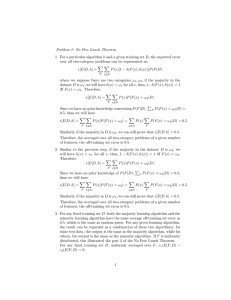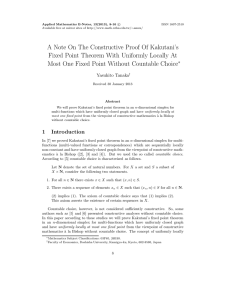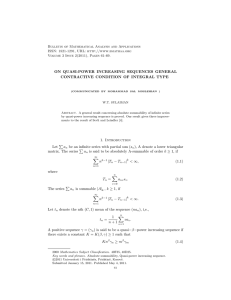Fall 2016, Math 409, Section 502
advertisement
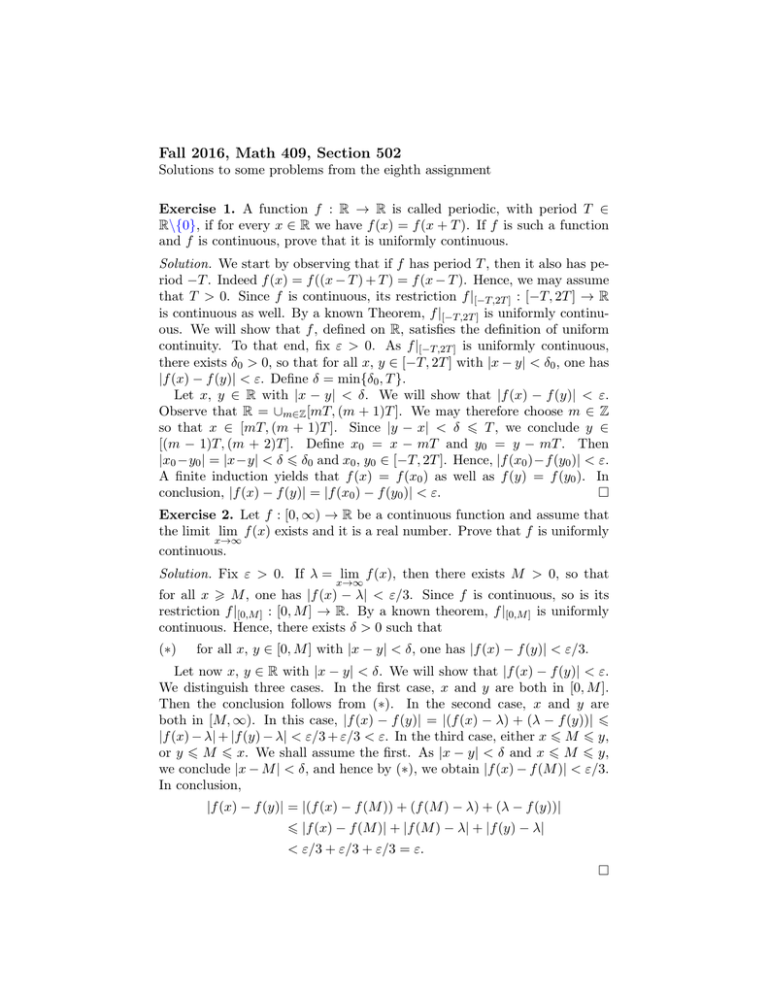
Fall 2016, Math 409, Section 502
Solutions to some problems from the eighth assignment
Exercise 1. A function f : R → R is called periodic, with period T ∈
R\{0}, if for every x ∈ R we have f (x) = f (x + T ). If f is such a function
and f is continuous, prove that it is uniformly continuous.
Solution. We start by observing that if f has period T , then it also has period −T . Indeed f (x) = f ((x − T ) + T ) = f (x − T ). Hence, we may assume
that T > 0. Since f is continuous, its restriction f |[−T,2T ] : [−T, 2T ] → R
is continuous as well. By a known Theorem, f |[−T,2T ] is uniformly continuous. We will show that f , defined on R, satisfies the definition of uniform
continuity. To that end, fix ε > 0. As f |[−T,2T ] is uniformly continuous,
there exists δ0 > 0, so that for all x, y ∈ [−T, 2T ] with |x − y| < δ0 , one has
|f (x) − f (y)| < ε. Define δ = min{δ0 , T }.
Let x, y ∈ R with |x − y| < δ. We will show that |f (x) − f (y)| < ε.
Observe that R = ∪m∈Z [mT, (m + 1)T ]. We may therefore choose m ∈ Z
so that x ∈ [mT, (m + 1)T ]. Since |y − x| < δ 6 T , we conclude y ∈
[(m − 1)T, (m + 2)T ]. Define x0 = x − mT and y0 = y − mT . Then
|x0 −y0 | = |x−y| < δ 6 δ0 and x0 , y0 ∈ [−T, 2T ]. Hence, |f (x0 )−f (y0 )| < ε.
A finite induction yields that f (x) = f (x0 ) as well as f (y) = f (y0 ). In
conclusion, |f (x) − f (y)| = |f (x0 ) − f (y0 )| < ε.
Exercise 2. Let f : [0, ∞) → R be a continuous function and assume that
the limit lim f (x) exists and it is a real number. Prove that f is uniformly
x→∞
continuous.
Solution. Fix ε > 0. If λ = lim f (x), then there exists M > 0, so that
x→∞
for all x > M , one has |f (x) − λ| < ε/3. Since f is continuous, so is its
restriction f |[0,M ] : [0, M ] → R. By a known theorem, f |[0,M ] is uniformly
continuous. Hence, there exists δ > 0 such that
(∗)
for all x, y ∈ [0, M ] with |x − y| < δ, one has |f (x) − f (y)| < ε/3.
Let now x, y ∈ R with |x − y| < δ. We will show that |f (x) − f (y)| < ε.
We distinguish three cases. In the first case, x and y are both in [0, M ].
Then the conclusion follows from (∗). In the second case, x and y are
both in [M, ∞). In this case, |f (x) − f (y)| = |(f (x) − λ) + (λ − f (y))| 6
|f (x) − λ| + |f (y) − λ| < ε/3 + ε/3 < ε. In the third case, either x 6 M 6 y,
or y 6 M 6 x. We shall assume the first. As |x − y| < δ and x 6 M 6 y,
we conclude |x − M | < δ, and hence by (∗), we obtain |f (x) − f (M )| < ε/3.
In conclusion,
|f (x) − f (y)| = |(f (x) − f (M )) + (f (M ) − λ) + (λ − f (y))|
6 |f (x) − f (M )| + |f (M ) − λ| + |f (y) − λ|
< ε/3 + ε/3 + ε/3 = ε.
Exercise 3. Let f : [0, 1] → R be a continuous function and let ε > 0.
Prove that there exists n ∈ N so that for k = 1, . . . , n we have
k−1
k−1
k
k
− inf f (x) :
< ε.
sup f (x) :
6x6
6x6
n
n
n
n
Solution. Since f is continuous defined on a bounded closed interval, it is
uniformly continuous. Hence, there exists δ > 0, that for all x, y ∈ [0, 1]
with |x − y| < δ, one has |f (x) − f (y)| < ε. By the Archimedian property of
R, there exists n ∈ N, such that 1/n 6 δ. We will show that this n satisfies
the desired property.
Let 1 6 k 6 n. By the extreme value theorem, there exist x0 , y0 in
k
[(k − 1)/n, k/n], so that f (x0 ) = sup{f (x) : k−1
n 6 x 6 n } and f (y0 ) =
k−1
k
inf{f (x) : n 6 x 6 n }. As x0 , y0 ∈ [(k − 1)/n, k/n], we have |x0 − y0 | <
1/n 6 δ and therefore |f (x0 ) − f (y0 )| < ε. In conclusion,
k
k−1
k
k−1
6x6
− inf f (x) :
6x6
sup f (x) :
n
n
n
n
= f (x0 ) − f (y0 ) 6 |f (x0 ) − f (y0 )| < ε.
Exercise 4. Let n ∈ Z, and f : (0, +∞) → R be the function f (x) = xn .
Prove that f 0 (x) = nxn−1 for all x ∈ (0, +∞).
Solution. If n = 0 then f (x) = 1, f 0 (x) = 0 for all x > 0, hence the
conclusion holds. We shall first prove by induction on n ∈ N, that if fn :
(0, +∞) → R is defined by fn (x) = xn , then fn0 (x) = nxn−1 .
For n = 1, f1 (x) = x and f10 (x) = 1, i.e. the conclusion holds. If we
assume that the conclusion folds for some n ∈ N and fn+1 : (0, +∞) → R is
the function fn+1 (x) = xn+1 , then f (x) = x · xn = f1 (x)fn (x). Hence, by
the production rule and the inductive assumption, fn+1 (x) = f10 (x)fn (x) +
f1 (x)fn0 (x) = xn + xnxn−1 = (n + 1)xn .
The induction is complete, hence we have shown the conclusion for n ∈ Z
with n > 0. If n ∈ Z, with n < 0, then n = −k for some k ∈ N. Then,
if f (x) = xn and g(x) = xk , we have f (x) = 1/g(x). By the quotient rule
and the fact that k ∈ N, we obtain f 0 (x) = −g 0 (x)/g 2 (x) = −kxk−1 /x2k =
(−k)x−k−1 = nxn−1 .
